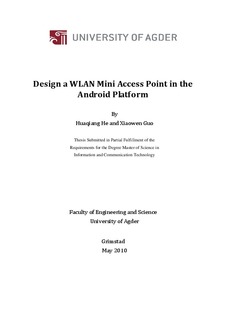| dc.description.abstract | Mobile as a computing platform is becoming more and more popular. The amount of such devices
shipped every year is growing rapidly, more than 1.2 billion in 2009. At the same time the WLAN is
being widely adapted at various locations like campuses, meeting rooms, stations, etc. Currently almost
all smart phones come with the support for the WLAN. However, most the mobile devices can only
behavior as a client in the WLAN. It would be a remarkable feature if the mobile device is able to
function as an Access Point (AP) and a modem which forwards data between the 3G network and the
WLAN. Android designed for handheld devices has become a popular and powerful platform in both
the industry and amateur developer community. Presently there is no WLAN AP mode supported in the
Android platform, therefore it’s an interesting task for us to implement such a function.
We start with studying the software AP hostapd. We set up a WLAN with hostapd running in a
Ubuntu Linux platform, instead of a hardware AP. By doing this we figure out the elements needed to
achieve the software AP functionality. Next we explore the Android building system, understand the
mechanism the building system works, and learn the way add new modules that we prepare to add into
the platform. With these basics we take all the elements needed into Android source code hierarchy and
build them into the final executables. Testing cases are given both in Ubuntu Linux platform and the
Android platform. To make the user experience better we design an application in the Android platform
for controlling the AP built from hostapd and other components.
Through the process we have done many experiments and have gained rich experience and knowledge
in the Linux operating system, Linux wireless implementation, wireless drivers, Android building
system, and Android application development. Some of them are enhancement to the existing
knowledge in various websites, and some are new to all the members in the development community.
These are all recorded in the thesis. For the final testing we succeed in both steps. First, the peripheral
stations can discover the AP in the Android platform and all stations are able to connect to it. There is
no difference between connection to the AP in the Android platform and connection to a normal
hardware AP device. Secondly, the data packets are successfully transmitted between stations, which
means there is no barrier in the AP in the Android platform for providing data service. From the view of
networking layering, we conclude that we succeed in both link layer and application layer. | en_US |
